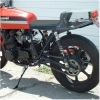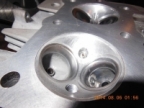how to measure valve clearance
- Patton
-

- Offline
- KZr Legend
-

Registered
- Posts: 18568
- Thanks: 2103
Re: how to measure valve clearance
01 May 2016 15:22Patton wrote: Perhaps just laziness, but for me it's so easy to just address each valve individually by pointing the cam lobe away and measuring, and not having to align T marks, etc. . . .
Finished up some time ago and still waiting for all you guys here at the bar.
Drinks are on me (if there's any left by the time you get here). :kiss:
Good Fortune!
1973 Z1
KZ900 LTD
KZ900 LTD
Please Log in or Create an account to join the conversation.
- jberger635
-
- Offline
- User
-

Registered
- Posts: 10
- Thanks: 1
Re: how to measure valve clearance
01 May 2016 18:44
Make sure the cam lobe is on the base circle, stick the feeler gauge in there and that's your valve clearance. Do not over-complicate it is literally that simple.
Please Log in or Create an account to join the conversation.
- Nessism
-
- Away
- Sustaining Member
-

Registered
- Posts: 7903
- Thanks: 3276
Re: how to measure valve clearance
01 May 2016 19:25jberger635 wrote: Make sure the cam lobe is on the base circle, stick the feeler gauge in there and that's your valve clearance. Do not over-complicate it is literally that simple.
I hope you are not a doctor.
Ed
Carb O-ring Kits : www.kzrider.com/forum/3-carburetor/61807...-o-ring-kits?start=0
www.kzrider.com/forum/faq-wiki/618026-new-owner-things-to-know
1981 KZ750E2
www.kzrider.com/forum/11-projects/604901...z750e-project-thread
Carb O-ring Kits : www.kzrider.com/forum/3-carburetor/61807...-o-ring-kits?start=0
www.kzrider.com/forum/faq-wiki/618026-new-owner-things-to-know
1981 KZ750E2
www.kzrider.com/forum/11-projects/604901...z750e-project-thread
The following user(s) said Thank You: 650ed, SWest
Please Log in or Create an account to join the conversation.
- loudhvx
-

- Offline
- KZr Legend
-

Registered
- Posts: 10864
- Thanks: 1619
Re: how to measure valve clearance
01 May 2016 22:28 - 01 May 2016 22:30
We are not really discussing the best way to do something. I'm pretty sure we've already stated that most of the methods mentioned work fine for most purposes.
But you can learn a lot going through these exercises.
The question is, what actually is the FSM method. It is clear now, that the FSM method is designed to push the cam upward in the cam caps. When two valve clearances are being measured on a given camshaft, the other two valves are pushing the camshaft upward by some amount. This would serve to reduce/eliminate random play in the journals, while not pushing so hard as to distort the camshaft.
I think I found a photo showing the "T" mark is basically 90 degrees away from the "EX" mark. With that, plus what 650Ed posted, it seems the 650 FSM procedure is effectively the same as the 550 FSM procedure, even though the unfortunate use of conflicting timing marks (on 650 sprockets vs 550 sprockets) would lead one to think otherwise.
When #1 is at TDC on its fire stroke, measure 1 and 3 intake.
When #2 is at TDC on its fire stroke, measure 2 and 4 exhaust.
When #4 is at TDC on its fire stroke, measure 2 and 4 intake.
When #3 is at TDC on its fire stroke, measure 1 and 3 exhaust.
But you can learn a lot going through these exercises.
The question is, what actually is the FSM method. It is clear now, that the FSM method is designed to push the cam upward in the cam caps. When two valve clearances are being measured on a given camshaft, the other two valves are pushing the camshaft upward by some amount. This would serve to reduce/eliminate random play in the journals, while not pushing so hard as to distort the camshaft.
I think I found a photo showing the "T" mark is basically 90 degrees away from the "EX" mark. With that, plus what 650Ed posted, it seems the 650 FSM procedure is effectively the same as the 550 FSM procedure, even though the unfortunate use of conflicting timing marks (on 650 sprockets vs 550 sprockets) would lead one to think otherwise.
When #1 is at TDC on its fire stroke, measure 1 and 3 intake.
When #2 is at TDC on its fire stroke, measure 2 and 4 exhaust.
When #4 is at TDC on its fire stroke, measure 2 and 4 intake.
When #3 is at TDC on its fire stroke, measure 1 and 3 exhaust.
1981 KZ550 D1 gpz.
Kz550 valve train warning.
Other links.
Kz550 valve train warning.
Other links.
Last edit: 01 May 2016 22:30 by loudhvx.
Please Log in or Create an account to join the conversation.
- loudhvx
-

- Offline
- KZr Legend
-

Registered
- Posts: 10864
- Thanks: 1619
Re: how to measure valve clearance
01 May 2016 22:32 - 01 May 2016 23:24Patton wrote:Patton wrote: Perhaps just laziness, but for me it's so easy to just address each valve individually by pointing the cam lobe away and measuring, and not having to align T marks, etc. . . .
Finished up some time ago and still waiting for all you guys here at the bar.
Drinks are on me (if there's any left by the time you get here). :kiss:
Good Fortune!
Yes, we know where you are. We could hear your valves rattling from across town.
1981 KZ550 D1 gpz.
Kz550 valve train warning.
Other links.
Kz550 valve train warning.
Other links.
Last edit: 01 May 2016 23:24 by loudhvx.
Please Log in or Create an account to join the conversation.
- Kray-Z
-

- Offline
- User
-

Registered
- I need more power Scotty....
- Posts: 583
- Thanks: 107
Re: how to measure valve clearance
02 May 2016 01:24 - 02 May 2016 03:14loudhvx wrote: We are not really discussing the best way to do something. I'm pretty sure we've already stated that most of the methods mentioned work fine for most purposes.
But you can learn a lot going through these exercises.
The question is, what actually is the FSM method. It is clear now, that the FSM method is designed to push the cam upward in the cam caps. When two valve clearances are being measured on a given camshaft, the other two valves are pushing the camshaft upward by some amount. This would serve to reduce/eliminate random play in the journals, while not pushing so hard as to distort the camshaft.
I think I found a photo showing the "T" mark is basically 90 degrees away from the "EX" mark. With that, plus what 650Ed posted, it seems the 650 FSM procedure is effectively the same as the 550 FSM procedure, even though the unfortunate use of conflicting timing marks (on 650 sprockets vs 550 sprockets) would lead one to think otherwise.
When #1 is at TDC on its fire stroke, measure 1 and 3 intake.
When #2 is at TDC on its fire stroke, measure 2 and 4 exhaust.
When #4 is at TDC on its fire stroke, measure 2 and 4 intake.
When #3 is at TDC on its fire stroke, measure 1 and 3 exhaust.
Hey, just one guy's opinion...
Absolutely nothing wrong with the FSM method - If you don't mind aligning the marks, checking the clearances, and constantly referring back to the manual, and being precise with aligning those marks and counting crank revolutions and making sure the timing chain isn't worn beyond spec (anywhere along it's length - they don't wear evenly) or slack on the "pull" side while you are lining things up. You must be sure the cam isn't on an acceleration / deceleration ramp when you check the clearance! It is also true that the specified clearances listed in the manual were calculated with this method in mind.
I personally like the sure and simple way - check and adjust (shim) while you know clearly that the lifter is on the base circle, i.e. when the lobe is facing 180 deg. away from the lifter. Removing the plugs makes turning the engine easy enough that it only takes a few more minutes this way. Not a big concern if you aren't working in the service department at a bike dealer and the boss is timing you. The difference (if any) that you might find in the clearances from this method vs. the FSM will be negligible given the tolerances of the acceptable valve clearances.
As for those who believe the FSM method was written to somehow mimic the valve clearances while the engine is operating, seriously - give your head a shake...taking up the clearance in the cam bearings for accurate clearance measurement? Get real. If that happened in a running engine, what you would have is scored / seized bearings from oil starvation. Flex and distortion in the camshaft from adjacent valve springs while the engine is stopped and cold? Again, nothing compared with the dynamic vibrations, twisting and flexing when the engine is hot / operating, even at idle speeds. Have any of you talked with a mechanical engineer about this? Do you know what causes those strange "wear" marks on the main and rod big end bearing journals and mating surfaces on healthy used engines? The inside of an operating reciprocating engine is a place of utter chaos. Even the strongest parts distort / loose their shape and deform from the stresses of inertia and load. Just calculate how many times each second the pistons have to violently change directions. Then calculate how fast they are moving at max. velocity at redline. If any non - engineer thinks they have it all figured out - guess again. Even then, strange things can happen. I've seen gold colored triple valve springs burn off oil and turn blue - grey in a matter of a few seconds from heat caused by high frequency harmonic vibration on a 330 c.i. V-8 racing engine at 11 000 rpm on the dyno...
Oh yeah - the 8V KZ series is easy to work with! That is why I chose it over the 16V GS1100/1150. For some real fun with valves, you all must try the 20V Yamahas and 24V CBX! Heck the CBX even has four cams (and two timing chains) to play with...
2-04 R1, 81 CSR1000, 81 LTD1000, 2-83 GPz1100, 3-79CBX, 81 CBX, 3-XS650, 84 Venture, +parts
Quote "speed costs money...how fast do you want to go?" (Which Z movie?)
Universal formula for how many motorcycles one should own = n + 1, where n is how many motorcycles you own right now....
Quote "speed costs money...how fast do you want to go?" (Which Z movie?)
Universal formula for how many motorcycles one should own = n + 1, where n is how many motorcycles you own right now....
Last edit: 02 May 2016 03:14 by Kray-Z. Reason: stuff to add
Please Log in or Create an account to join the conversation.
- Patton
-

- Offline
- KZr Legend
-

Registered
- Posts: 18568
- Thanks: 2103
Re: how to measure valve clearance
02 May 2016 04:31 - 02 May 2016 14:34loudhvx wrote: . . . Finished up some time ago and still waiting for all you guys here at the bar.
Drinks are on me (if there's any left by the time you get here). :kiss: . . . .
Yes, we know where you are. We could hear your valves rattling from across town.
:lol: :lol: :lol:
But that was Kevin's that you were hearing.
My fossilized technique traces back to the original 1973 Z1 Owner's Manual that came with my brand new Z1, which says, "Use a wrench on the crankshaft rotation nut to turn the engine over so that the highest part of the cam to be measured is pointing directly away from the valve lifter." And includes a photo showing a feeler gauge being inserted between the cam lobe and shim with the lobe pointed directly opposite the shim.
From: Z1 Owner's Manual
The FSM for Z1-KZ900 says the same thing, as does the Chilton's Kawasaki 900 Z1 Repair and Tune-Up Guide (1974 First Edition), along with consistent valve adjustment charts and diagrams.
From FSM for Z1-KZ900
Note cam lobe position in the diagram ^ ^ ^.
From Chilton's Guide [The red part is added by me.]
Thereafter, the FSM for 1977-1979 KZ1000 (covering models A1, A2 A3, D1 and D2) introduced alignment of marks on the camshaft sprocket with surface of the cylinder head in conjunction with measuring clearance, where the cam lobes aren't pointing directly away from the shims, and allows for measuring 2 valves at a time (1 and 3, or 2 and 4) . Accompanied with explanatory pictures and diagrams.
From FSM for KZ1000
Also from FSM for KZ1000
Note cam lobe position in the diagram ^ ^ ^.
Missing you guys while sitting here at last call with Kevin Cameron who's saying, ""When they're click'n, they ain't stick'n." :woohoo:
And he must be pretty smart 'cause he calls 'em feeler gauges just like I do, instead of thickness gauges.
Good Fortune!
1973 Z1
KZ900 LTD
KZ900 LTD
Attachments:
Last edit: 02 May 2016 14:34 by Patton.
Please Log in or Create an account to join the conversation.
- SWest
-

- Offline
- Sustaining Member
-

Registered
- 10 22 2014
- Posts: 23566
- Thanks: 2951
Re: how to measure valve clearance
02 May 2016 06:48
At least there is a discussion on adjusting the valves.  It's like pulling teeth trying to convince a new owner to do it. They go straight to the carbs of ignition. :blink: :blink: :blink: Whether done the lazy way or the correct way at least they're being done. :whistle:
It's like pulling teeth trying to convince a new owner to do it. They go straight to the carbs of ignition. :blink: :blink: :blink: Whether done the lazy way or the correct way at least they're being done. :whistle:
BTW I've always called them feeler gauges and everyone I know do. :dry:
Steve
BTW I've always called them feeler gauges and everyone I know do. :dry:
Steve
Z1b1000 1975 Z1b
kzrider.com/forum/11-projects/598262-kz-...-will-it-live#672882
kzrider.com/forum/2-engine/597654-poser?start=240#704229
kzrider.com/forum/11-projects/598262-kz-...-will-it-live#672882
kzrider.com/forum/2-engine/597654-poser?start=240#704229
Please Log in or Create an account to join the conversation.
- Patton
-

- Offline
- KZr Legend
-

Registered
- Posts: 18568
- Thanks: 2103
Re: how to measure valve clearance
02 May 2016 07:38 - 02 May 2016 07:39
Yes. And when trying to encourage well-intentioned novices, it's likely not the greatest idea to initially bombard them with all sorts of things to be remembered such as marks on cam sprockets, aligning the marks, which valves to measure when which marks are aligned on which cam sprocket. Groan.
Not at all to say that more in-depth learning may be both beneficial and enjoyable, but meanwhile the "Git'er done" approach of simply "point away and measure" has a lot going for it if for no better reason than being far better than nothing.
Good Fortune!
Not at all to say that more in-depth learning may be both beneficial and enjoyable, but meanwhile the "Git'er done" approach of simply "point away and measure" has a lot going for it if for no better reason than being far better than nothing.
Good Fortune!
1973 Z1
KZ900 LTD
KZ900 LTD
Attachments:
Last edit: 02 May 2016 07:39 by Patton.
Please Log in or Create an account to join the conversation.
- SWest
-

- Offline
- Sustaining Member
-

Registered
- 10 22 2014
- Posts: 23566
- Thanks: 2951
Re: how to measure valve clearance
02 May 2016 07:56
Yup and add to that on the smaller fours the cams have to be removed to replace the shims. I console them with it's a HP mod for race bikes with high lift cams on the big fours.  That seems to help them understand the why's. :whistle:
That seems to help them understand the why's. :whistle:
Steve
Steve
Z1b1000 1975 Z1b
kzrider.com/forum/11-projects/598262-kz-...-will-it-live#672882
kzrider.com/forum/2-engine/597654-poser?start=240#704229
kzrider.com/forum/11-projects/598262-kz-...-will-it-live#672882
kzrider.com/forum/2-engine/597654-poser?start=240#704229
Please Log in or Create an account to join the conversation.
- loudhvx
-

- Offline
- KZr Legend
-

Registered
- Posts: 10864
- Thanks: 1619
Re: how to measure valve clearance
02 May 2016 08:06 - 02 May 2016 08:24
I call them floppy weasels.
The "pointing away from the buckets" method is so simple and easy, and was already so established in the Kawasaki literature, it makes you wonder, what reason was so compelling to cause Kawasaki to change all of the graphics and text for all of their service manuals. That must have been a huge expenditure, and not something you would do for no reason.
Since Kawasaki felt it had a good reason for changing the procedure, and since it is also pretty simple, and since it's already completely spelled out in the manual, we don't have to explain it to any newbs, we just have to say "follow the instructions in the manual". If they can't follow those simple instructions, they should not be working on the engine. (That includes many pro's, I'm afraid.)
On the later, hyvo-chain motors, it's no harder than checking the ignition timing (you only need to set the crank using the advancer markings). On the 650, and the early Kz1000, you have to look at cam-sprocket markings.
I will admit, that Kz1000 FSM is a little vague.. "until the marks on the appropriate camshaft sprocket line up". It is likely self-explanatory when you actually have your hands on the motor.
Anyway, thanks Patton, for posting that. Now we have confirmation that Kawasaki, at some point, detailed all three inline-four Kz families to follow the same procedure for valve clearance.
Like I said, I've done it both ways, FSM vs point-away, and the results did differ slightly.
The "pointing away from the buckets" method is so simple and easy, and was already so established in the Kawasaki literature, it makes you wonder, what reason was so compelling to cause Kawasaki to change all of the graphics and text for all of their service manuals. That must have been a huge expenditure, and not something you would do for no reason.
Since Kawasaki felt it had a good reason for changing the procedure, and since it is also pretty simple, and since it's already completely spelled out in the manual, we don't have to explain it to any newbs, we just have to say "follow the instructions in the manual". If they can't follow those simple instructions, they should not be working on the engine. (That includes many pro's, I'm afraid.)
On the later, hyvo-chain motors, it's no harder than checking the ignition timing (you only need to set the crank using the advancer markings). On the 650, and the early Kz1000, you have to look at cam-sprocket markings.
I will admit, that Kz1000 FSM is a little vague.. "until the marks on the appropriate camshaft sprocket line up". It is likely self-explanatory when you actually have your hands on the motor.
Anyway, thanks Patton, for posting that. Now we have confirmation that Kawasaki, at some point, detailed all three inline-four Kz families to follow the same procedure for valve clearance.
Like I said, I've done it both ways, FSM vs point-away, and the results did differ slightly.
1981 KZ550 D1 gpz.
Kz550 valve train warning.
Other links.
Kz550 valve train warning.
Other links.
Last edit: 02 May 2016 08:24 by loudhvx.
Please Log in or Create an account to join the conversation.
- loudhvx
-

- Offline
- KZr Legend
-

Registered
- Posts: 10864
- Thanks: 1619
Re: how to measure valve clearance
02 May 2016 08:09 - 02 May 2016 08:09It's like anything. The first time sucks. After a few times, you develop a system, and gather the necessary tools, then it's easy. The hardest part is scraping the valve cover gasket. I only do that the first time, then polish and antiseize take care of the following times.swest wrote: Yup and add to that on the smaller fours the cams have to be removed to replace the shims. I console them with it's a HP mod for race bikes with high lift cams on the big fours.That seems to help them understand the why's. :whistle:
Steve
1981 KZ550 D1 gpz.
Kz550 valve train warning.
Other links.
Kz550 valve train warning.
Other links.
Last edit: 02 May 2016 08:09 by loudhvx.
Please Log in or Create an account to join the conversation.
Moderators: Street Fighter LTD

